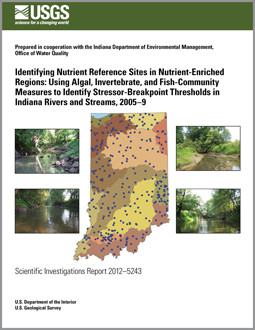
Product Details
- Product Number
- 250658
- Series
- SIR-2011-5009
- Scale
- NO SCALE
- Alternate ID
- SIR-2011-5009
- ISBN
- 978-1-4113-3103-7
- Authors
- DAVID L LORENZ
- Version Date
- 01/01/2011
- Countries
- USA
- Media
- Paper
- Format
- Bound
Additional Details
- Description
- The algal, invertebrate, and fish taxa and community attributes that best reflect the effects of nutrients along a gradient of low to high nutrient concentrations in wadeable, primarily midwestern streams were determined as part of the U.S. Geological Suvey#s National Water-Quality Assessment (NAWQA) Program. Nutrient data collected from 64 sampling sites that reflected reference, agricultural, and urban influences between 1993 and 2006 were used to represent the nutrient gradient within Nutrient Ecoregion VI (Cornbelt and Northern Great Plains), VII (Mostly Glaciated Dairy Region), and VIII (Nutrient Poor Largely Glaciated Upper Midwest and Northeast). Nutrient Ecoregions VII and VIII comprise the Glacial North diatom ecoregion (GNE) and Nutrient Ecoregion VI represents the Central and Western Plains diatom ecoregion (CWPE). The diatom-ecoregion groupings were used chiefly for data analysis. The total nitrogen (TN) and total phosphorus (TP) data from 64 sites, where at least 6 nutrient samples were collected within a year at each site, were used to classify the sites into low-, medium-, and high-nutrient categories based upon the 10th and 75th percentiles of for sites within each Nutrient Ecoregion. In general, TN and TP concentrations were 3#5 times greater in Nutrient Ecoregion VI than in Nutrient Ecoregions VII and VIII. A subgroup of 54 of these 64 sites had algal-, invertebrate-, and fish-community data that were collected within the same year as the nutrients; these sites were used to assess the effects of nutrients on the biological communities. Multidimensional scaling was used to determine whether the entire region could be assessed together or whether there were regional differences between the algal, invertebrate, and fish communities. The biological communities were significantly different between the northern sites, primarily in the GNE and the southern sites, primarily in the CWPE. In the higher nutrient concentration gradient in the streams of the CWPE, algae exhibited greater differences than invertebrates and fish between all of the nutrient categories for both TN and TP; however, in the lower nutrient gradient in the streams of the GNE, invertebrates exhibited greater differences between the nutrient categories. Certain species of algae, invertebrates, and fish were more prevalent in low- and high-nutrient categories within each of the diatom ecoregions. Breakpoint analysis was used to identify the concentration at which the relations between the response variable (biological attribute) and the stressor variable (TN and TP) change. There were significant breakpoints for nutrients (TN and TP) and multiple attributes for algae, invertebrates, and fish communities within the CWPE and GNE diatom ecoregions. In general, more significant breakpoints, with lower concentrations, were found in the GNE than the more nutrient-rich CWPE. The breakpoints from all biological communities were generally about 3#5 times higher in the south (CWPE) than the north (GNE). In the north, breakpoints with similar lower concentrations were found for TN from all biological communities (around 0.60 milligram per liter) and for TP (between 0.02 and 0.03 milligram per liter) for the algae and invertebrate communities. The findings from our study suggest that the range in breakpoints for TN and TP from the GNE can be used as oligotrophic and eutrophic boundaries derived from biological response based on this ecoregion having (1) a gradient with sufficiently low to high nutrient concentrations, (2) distinctive differences in the biological communities in the low- to high-nutrient streams, (3) similarity of breakpoints within algal, invertebrate, and fish communities, (4) significant attributes with either direct relations to nutrients or traditional changes in community structure (that is, decreases in sensitive species or increases in tolerant species), and (5) similar breakpoints in other studies in this and other regions. In nutrient-rich areas like the CWPE, all of the breakpoints were substantially higher than those for the lower nutrient conditions of the GNE, suggesting that streams are nutrient saturated to the point that low-end breakpoints cannot be detected.
- Survey Date
- 2011
- Print Date
- 2011
- Height In Inches
- 11.000
- Width In Inches
- 0.250
- Length In Inches
- 8.500
- Two Sided
- Yes
- Pieces
- 1
- Languages
- English
Related Items




